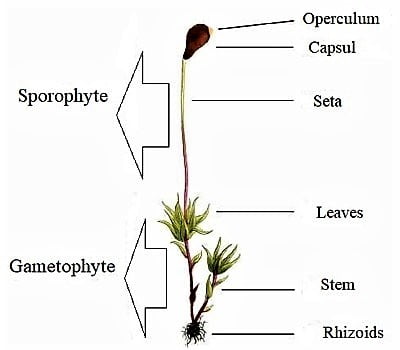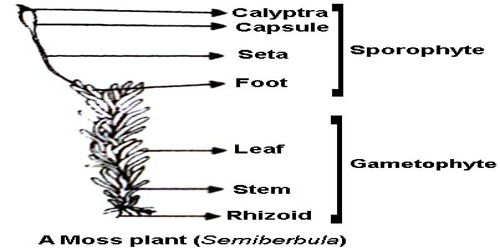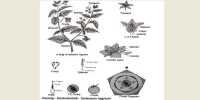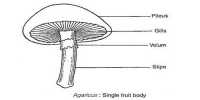The sporophyte is the diploid phase of the alternation of generations, a method which allows sexual and asexual reproduction to prevent destructive genes to be reproduced. Moss is a non-vascular plant, meaning that it has no internal system to transport water.
Sporophyte of Semibarbula or Moss: Zygote is the first cell of the sporophyte. The zygote (2n) divides, develops and eventually produces a sporophyte, called sporogonium. This sporogonium has three parts.
(I) Foot
(II) Seta &
(III) Capsule

Fig: A moss plant
Foot: The lower part of seta which keeps the sporophyte attached with gametophyte is called a foot. It functions as an anchoring and absorbing organ.
Function: Sporophyte absorbs food and water from garnetophore through the foot.
Seta: It is a long, soft and slender part of sporophyte that bears the capsule at its tip. It bears the capsule at its tip. It raises the capsule above the apex of leafy gametophore.
Function: Conducts food for the capsule. It is mechanical in function and also conducts the water and nutrients to the developing capsule.
Capsule: It is the terminal part of the sporophyte and is developed at the apex of the seta. It is green in color when young but on development, it becomes bright orange colored.
The following parts are found in the longitudinal section of the moss capsule.
(i) Apophyses, (ii) Capsule wall, (iii) Air cavity, (iv) Sporangium, (v) Columella, (vi) Operculum, (vii) Annulus & (viii) Peristome.
- Apophyses: The swollen part at the attachment of the capsule and seta is called apophyses. Its surrounding area is composed of parenchyma cells and well fitted with stomata. It is the photosynthetic region and connects seta with the capsule.
- Capsule wall: It is composed of multilayered sterile cells enriched with chloroplasts.
- Air cavity: The cavities present to between capsule wall and sporangium are known as air cavities the walls remaining in the air cavities are called trabeculae. These are present just below the spongy parenchyma and outside the spore sacs.
- Sporangium: Sporangium is made by one to many-celled layers Spore mother cells are formed from this sporangium. These cells are capable to manufacture their own food but dependent on gametophyte for water and mineral nutrients.
- Columella: It is the sterile region situated at the center of the capsule. It is the central part of the theca region. It is made up of compactly arranged colorless parenchymatous cells. It helps in the conduction of water and mineral nutrients.
- Operculum: Situated at the tip of the capsule and it acts as a lid covering the peristome. It is composed of multi-layered parenchyma cells. It is the upper region of the capsule. It is dome shaped and consists of four to five layers of cells. The outermost layer is thick walled and called epidermis.
- Annulus: It is a band Re tissue which is the connecting link between the operculum and the opening of capsule When the capsule attains maturity, annulus breaks down and the spores come out.
- Peristome: Some tooth-like structure situated at the top of the columella is the peristome It is hygroscopic in nature and it regulates the dispersal of spores.
Function
The basic function of the sporophyte is to produce spores. The spores, in turn, produce the gametophytes that give rise to the male and female gametes through the procedure of meiosis. Meiosis is the type of cell division that reduces the number of chromosomes in half.
Without the sporophyte, the life cycle of plants will be disrupted and plants will not be capable to reproduce. Without it, fruits won’t develop and plants will simply rely on asexual methods of propagation. This weakens the hereditary pool of plant species.















